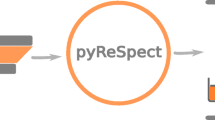Abstract
For describing the viscoelastic properties of polymeric materials, the continuous relaxation spectrum is proposed instead of the discrete spectrum of relaxation time distribution, which is usually employed in practical calculations. For polymer melts and solutions, such a continuous spectrum is assumed to be represented by a power function and to have a certain maximum relaxation time as its upper bound. The spectrum is determined by three constants: the upper bound (maximum relaxation time), slope in the logarithmic scale (exponent), and height (form factor). The necessity to find a small number of parameters is an advantage in comparison with the need to determine a large number of constants within the concept of a discrete relaxation time spectrum and corresponding weights. The central idea is that the parameters of the continuous spectrum can be unambiguously determined from the experimentally found integral characteristics (moments) of the viscoelastic behavior of the material: the viscosity, normal stress coefficient, and area under the relaxation curve after the cessation of steady flow. The proposed choice of the relaxation spectrum shape is shown to provide an adequate description of the specific features of viscoelastic behavior for melts of polymers with a varying MM.
Similar content being viewed by others
References
H. H. Winter, J. Non-Newtonian Fluid Mech. 68, 225 (1997).
W. Thimm, Ch. Freidrich, and M. Marth, J. Rheol. (N. Y.) 44, 429 (2000).
A. Ya. Malkin, Vysokomol. Soedin., Ser. B 44, 1598 (2002) [Polymer Science, Ser. B 44, 247 (2002)].
V. A. Dubovitskii and V. I. Irzhak, Vysokomol. Soedin., Ser. B 47, 121 (2005) [Polymer Science, Ser. B 47, 22 (2005)].
B. Gross, Mathematical Structure of the Theories of Viscoelasticity (Hermann, Paris, 1953).
G. V. Vinogradov and A. Ya. Malkin, Rheology of Polymers (Khimiya, Moscow, 1977; Springer, Heidelberg, 1980).
V. A. Kargin and G. L. Slonimskii, Zh. Fiz. Khim. 23, 563 (1949).
M. Doi, J. Non-Newtonian Fluid Mech. 23, 151 (1987).
J. Honerkamp, Rheol. Acta 28, 363 (1989).
A. Ya. Malkin, Rheol. Acta 29, 512 (1990).
I. Emri and N. W. Tschoegl, Rheol. Acta 32, 311 (1993).
A. Ya. Malkin and I. Masalova, Rheol. Acta 40, 261 (2001).
M. Baumgaertel, A. Schrausberger, and H. H. Winter, Rheol. Acta 29, 400 (1990).
A. Ya. Malkin, Rheol. Acta 7, 335 (1968).
G. V. Vinogradov, A. Ya. Malkin, Yu. G. Yanovsky, et al., Rheol. Acta 8, 490 (1969).
Author information
Authors and Affiliations
Additional information
Original Russian Text © A.Ya. Malkin, 2006, published in Vysokomolekulyarnye Soedineniya, Ser. A, 2006, Vol. 48, No. 1, pp. 49–56.
Rights and permissions
About this article
Cite this article
Malkin, A.Y. The use of a continuous relaxation spectrum for describing the viscoelastic properties of polymers. Polym. Sci. Ser. A 48, 39–45 (2006). https://doi.org/10.1134/S0965545X06010068
Received:
Revised:
Issue Date:
DOI: https://doi.org/10.1134/S0965545X06010068




